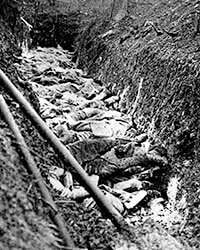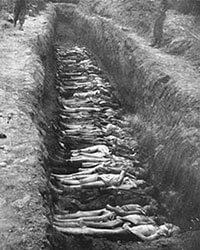 |
 |
| Mass-graves, World War I & the Holocaust |
|
The photos above show dead soldiers in a trench and dead Jews in a trench. Looking at the bodies of soldiers and Holocaust victims from a distance—subtracting ideology and the events that led to them to be there—all we see is dead human beings. Typically, one attributes “honor & glory” to the death of a soldier. No one utters these words about a Holocaust victim.
Does the Holocaust contain a subliminal anti-war message? Does a dead Jew lying in a trench (not unlike the trench in which a dead soldier lies) proclaim: “It is not sweet and beautiful to die for a country?” |
|
The Bulletin of COV&R (October 1999) reported on the 8th Annual Meeting of the Colloquium on Violence and Religion, June 2-6, 1999. I wrote about the talk I gave in Volume VI and Volume VII of the History of Library of Social Science.
A section of the Bulletin presented a summary of my presentation entitled “War as Sacrifice.” The reporter stated that the second day of meeting began with a “challenging and much debated treatment” of the Nazis and the Holocaust, in which I reflected on a series of parallel developments that “rendered Nazi soldiers increasingly similar to their Jewish victims.”
Koenigsberg argued, the report continued, that the ostensible goals of that war and others are subordinate to their “sacrificial imperative: to generate unity by requiring all groups in the state to place their lives at the disposal of the state.”
This statement conveys an idea I’ve tried to convey through the LSS Newsletter: that whatever war looks like in its myriad manifestations—fundamentally it is about the requirement that human beings “place their lives at the disposal of the state.”
One might even say that the purpose of war is that some human beings die. The death of human beings in war means that the state has been successful in getting people to submit to the sacrificial imperative.
Hitler insisted that Germans sacrifice their lives for Germany. Indeed, the essence of being a civilized human being, from his perspective, lay in the willingness of people to abandon their individuality in order to sacrifice their lives for a collective.
Jews were anathema because, according to Hitler, they were incapable of sacrificing for the collective. Hitler believed that the Jewish refusal to sacrifice—their willful individualism—was biologically given. They were incorrigible.
While Germans did not resist the sacrificial imperative, Jews rebelled against it. The Final Solution was undertaken to bring Jews into the fold. The only solution to their stubborn refusal to sacrifice was to compel them to die. Jews would be forced to “place their lives at the disposal of the state.”
The COV&R report on my talk goes on to say that although the requirements of sacrifice may vary greatly for each group, a “perverse unity is finally achieved as they become identified with one another by virtue of the fact that they all perform their designated sacrifice.”
The photos above show dead soldiers in a trench and dead Jews in a trench. If we subtract the reasons they arrived at this final destination, we can state simply that—in each instance—these the human beings are where they are as a result of actions taken by the German nation.
What differs is what one might say about these dead bodies. Hitler would say that the dead German soldier was virtuous and heroic: he had given his life for the Volk; had willingly made the “supreme sacrifice.”
Of course, he would not say the same thing about dead Jews. Jews died, Hitler would say, precisely because they lacked virtue. Since Jews are a people who refuse to sacrifice for a nation, they have to be compelled to die.
Looking at the bodies of soldiers and Holocaust victims from a distance—subtracting ideology and the complex chain of events that led to them to be lying in a trench—what we see is dead human beings. Focusing on these dead bodies, it is difficult to speak of honor or glory or heroism—or anything.
Does the Holocaust contain a subliminal anti-war message? Does a dead Jew lying in a trench (not unlike the trench in which a soldier lay) proclaim: “It is not sweet and beautiful to die for a country?” |